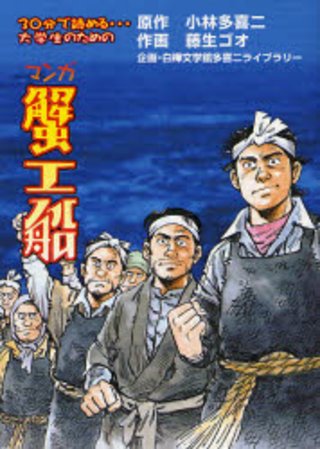Kanikosen: a proletarian literature classic comes back to life
By Matthew Ward
Go into a Japanese bookstore these days, and chances are you’ll see a little book with a black ship silhouetted against a red sky on its cover, prominently displayed next to other recent bestsellers. The book in question is called “Kanikosen,” written by the left-wing author Takiji Kobayashi, and, oddly enough, it was first published way back in 1929. The book’s title translates fairly literally as “Crab Factory Ship,” but I’ve also seen it translated as “The Cannery Boat.” It tells the story of a group of laborers struggling against brutal working conditions abroad a Japanese crab processing ship near Kamchatka, Russia. It is kind of like a Japanese version of “The Jungle” or “The Grapes of Wrath”; a story of proletariat workers being exploited and finally waking up and banding together against their oppressors. It has gotten a lot of press recently, for making a surprising comeback among young Japanese.
Before going on, I should explain that my own life experience given this book a powerful emotional resonance for me. When I was in my early 20’s, I worked on fish-processing ships in Alaska, including a stint on a crab processor in the Bering Sea, not too far from the area where Kanikosen is set. As such, the manga versions of this book take me into a strikingly familiar world, although my own kanikosen experience took place in a different culture and more than 60 years after this book was published.
The book opens with one of the workers declaring “Oi! Jigoku sa, igun da de!” (“Oi! We’re goin’ t’ HELL!” in a northern dialect) as they board the ship, which is not a statement that anybody who has ever worked in this industry would argue with much. Many other details are remarkably similar to my own experience: men who blow their hard-earned wages on prostitution and alcohol binges (although the people I worked with often replaced the alcohol with crack cocaine), the stink of the workers’ shared sleeping cabins, mail from home resulting in celebration and tears (pictures of new babies and food from home mixed with Dear John letters), the processors furtively sneaking some of the prize crab meat when the foremen aren’t looking, short-wave radios with news of crabbing boats going down in nearby icy waters, workers divided up into rival factions, and increasing despair and violence as the crabbing season goes on.
But, what probably affected me most was the workers themselves: although many are violent alcoholics and terminal screw-ups, they all have homes, families and professions that they they plan to return to and make a better life with the money they made processing fish. As translator Donald Keene puts it in his introduction to a chapter from the book that is included in the book “Modern Japanese Literature”: “The ship is manned by rough sailors, students from the universities, who have been tricked into believing the work is a desirable summer job, and boys from the farms of northern Japan.” The word “tricked” is highly relevant here: these workers have been sucked in by advertisements promising big money from a winter on a crab processor, and instead they are brutalized and cheated out of their wages.
This aspect of the book reminds me of The Grapes of Wrath, where economically desperate dust-bowl farmers are lured to California by advertisements promising good money picking fruit, but on arrival, they find that they are ripe for exploitation. It also reminds me again of my own experience in the early 1990’s, when I worked with people in Alaska who had literally sold everything and driven to Seattle to work in the fish processing industry—sometimes the misleading advertisements lead people to come during the off-season, and they end up homeless on the streets as their money runs out, looking for work in the fabled processing industry. In all of these situations, these people are human beings who are hoping desperately for a better life, and instead they are treated like garbage.
There are differences, of course. On the ship I worked on, although there was a lot of exploitation and the bosses rarely seemed to care much about our lives, health or safety, most of the violence occurred between the workers. In Kanikosen, the workers are victimized by a brutal and greedy foreman who has no qualms about literally working his crew to death in the name of company profits and Imperial Japan. The other difference, though, is that in Kanikosen, the workers eventually organize, form a union, go on strike, and take control of the ship, learning that their unity is their only protection.
One interesting thing about Kanikosen is how it attacks the increasingly fascist tendencies of its time. It repeatedly draws a direct connection between Imperial Japan and the exploitation of the workers on the ship, showing how fascism is, among other things, used to keep the working class under the thumb of the company owners, who are aided and abetted by the military, which at one point boards the ship to put brutally down a strike. The “wealthy nation, strong army” policies of the Meiji government are shown as being carried out at the expense of the working poor. It also portrays the utter contempt that the militarists had for Japanese working people, who saw them as idiotic children who needed to be controlled for their own good.
This paints a very different picture to the revisionist history peddled in recent years by the Japanese far-right. After all the fuss about the movie “Yasukuni,” it occurs to me that Kanikosen presents a much larger challenge to the far-right’s version of history. For example, Shinchosa Publishing Corporation, just one of the publishers putting out versions of Kanikosen these days, has raised the annual number of copies published from 2,000 to 57,000 to meet the demand for the novel—obviously, far more people are reading this novel than are watching “Yasukuni,” and it paints a version of Japanese history that young Japanese are increasingly not getting from their educational system. If I were of the far-right, I’d actually be a lot more concerned about Kanikosen than about Yasukuni.
The rightists would probably also label Kanikosen “anti-Japanese,” as they do everything that contradicts their nationalist version of history. But, a key moment in the book actually comes when some of the workers, in a smaller crabbing boat, get blown off course, and are rescued by Russians. They meet a Chinese man speaking broken Japanese who urges them to stand up for their rights as members of the working class. At first, they are suspicious of him, fearing that he is trying to convert them to Communism. But when he tells them that when Japanese working people stand up for their rights, Japan will become a better country, they become inspired, and return to their ship with a new consciousness. In other words, the workers are inspired partially by the love of their country.
So, what exactly is making this book a hit among young Japanese in 2008, nearly 80 years after it was first published? Young fans, many of them 20-something workers, are saying that they identify with the laborers in the novel. While for years, Japan’s kinder, gentler version of capitalism kept economic insecurity relatively low, the bursting of the economic bubble in the early 90’s, coupled with the increasingly dog-eat-dog world of Koizumi economics, have made the Japanese work world a far more insecure and precarious place, where exploitation of labor is becoming more common.
One young woman, Sanae Yamaguchi, herself a victim of modern-day labor exploitation, wrote an essay about the book that won the grand prize in a contest held by the Otaru University of Commerce, the university that Kanikosen author Tajiki Kobayashi graduated from (it was then called the Otaru School of Higher Learning). Yamaguchi explained that she envied the workers in Kanikosen because the sense of unity that they discovered.
All in all, it seems that you don’t need to have ever worked on a crab processing ship to identify with Kanikosen these days. As a promotional review written by a bookshop employee put it “The masterpiece has come back to life in the Heisei era, a time when the gap between rich and poor has widened.”
It’s also worth mentioning that not just Japan that has gone back to a past of greater economic inequality, either. For example, the American book “Fast Food Nation,” by Eric Slosser, has drawn comparison’s to Upton Sinclair’s “The Jungle,” partially because the horrific conditions in American meatpacking plants that Sinclair wrote about have largely returned in the new millennium. Just as The Jungle has become relevant again, so has Kanikosen.
Takiji Kobayashi, the author of Kanikosen, was jailed for his labor activities and tortured to death by the Imperial Police in 1933. He was only 29 years old. Although it is not a good thing that Japan and the world in general has become more like the world he wrote about, there is a kind of beautiful irony that, despite being murdered for his beliefs, his voice has come back to life in the 21st century. In Kobayashi’s time, the proletarian literary movement dominated Japanese writing, before being suppressed by government censorship and jailing of left-wing writers. Perhaps the return of Kanikosen will inspire some new working-class authors, and somehow I suspect that there is nothing that Kobayashi, who was born into rural poverty yet managed to become a major literary figure in his short life, would have been more pleased by.
By the way, Kanikosen has supposedly been translated into multiple languages, including English, although I don’t know if English-languages versions are available in Japan. There was also a movie version of it that came out in 1953. I’ve personally been reading the two manga versions of it, and have just started reading the original novel version–hopefully the novel won’t prove to be too much for my Japanese reading ability! At any rate, for those of limited Japanese reading ability, asking for “Kamikosen no manga-ban” at your local bookstore will hopefully produce a easier alternative. There is also the English translation of a chapter of the book that is included in Donald Keene’s “Modern Japanese Literature” that I mentioned above—this is another way to get a taste of a Japanese proletarian classic that has come back to life in the 21st century.





